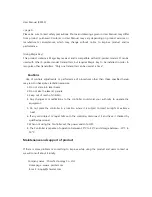
© National Instruments
|
1-7
NI 17xx User Manual
Although using a DHCP server simplifies IP address configuration, using a static IP address can
be more reliable. Consider the following potential issues before using a DHCP server to assign
an IP address to the NI 17xx Smart Camera:
•
If the network has both static IP addresses and IP addresses managed by a DHCP server,
the DHCP server must be configured to not use reserved static IP addresses. If the DHCP
server is not configured this way, the DHCP server can assign a reserved IP address to
another device, causing address conflicts on the network, which results in some devices
being unreachable.
When a NI 17xx Smart Camera configured for DHCP starts, it must be able to connect to the
DHCP server. If the NI 17xx Smart Camera cannot connect to the DHCP server and is not
connected to the same subnet as the development computer, it does not appear in MAX or Vision
Builder AI.
Note
TA NI 17xx Smart Camera connected directly to the development computer
or to the same subnet as the development computer is always configurable from
MAX or Vision Builder AI, regardless of the IP address settings.
Firewall Configuration
If you are having difficulty detecting the NI 17xx Smart Camera on your network, you must
configure the firewall to open the TCP/UDP ports used by the NI 17xx Smart Camera and the
host machine. The required ports are listed in Table 1-3.
If your firewall is controlled remotely or you are unsure about configuring the firewall, contact
your network administrator.
Table 1-3.
TCP/UDP Ports Used by the NI 17xx Smart Camera
Port
Type
Details
3580
TCP/UDP
Reserved as nati-svrloc (NAT-ServiceLocator). Used by
Measurement & Automation Explorer (MAX) to locate remote
targets.
7749
TCP
Used for remote image display (not reserved).
7750
TCP
Used for NI-IMAQ remote configuration (not reserved).
3363
TCP/UDP
Reserved as nati-vi-server (NATI VI Server). Used by Vision
Builder for Automated Inspection to configure a remote NI Smart
Camera.
















































